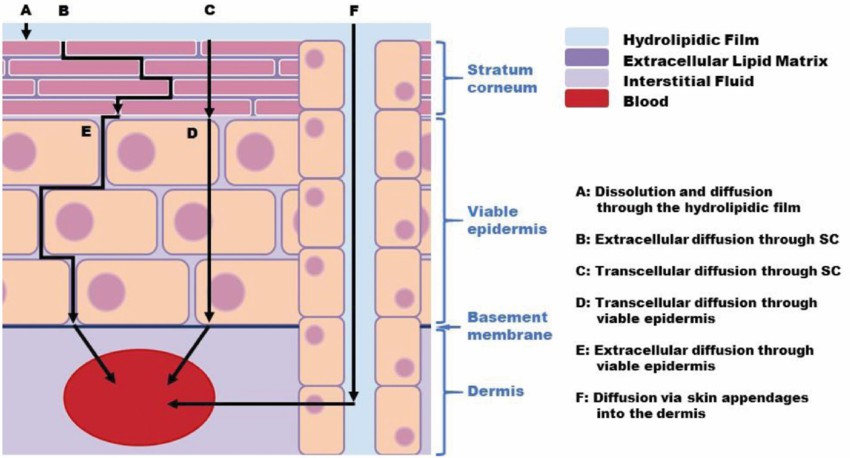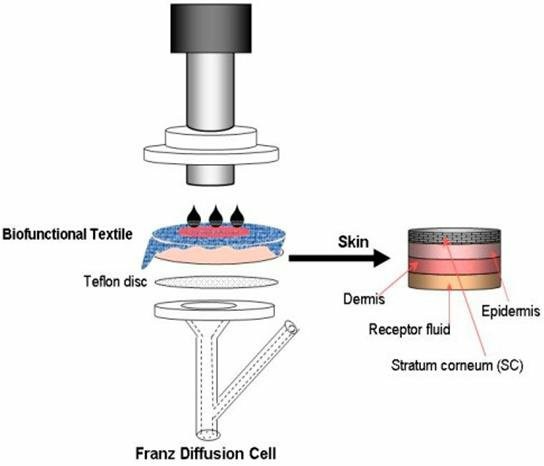- You are here: Home
- Applications
- Skin
- Dermatology
- Percutaneous Absorption
Applications
-
Cell Services
- Cell Line Authentication
- Cell Surface Marker Validation Service
-
Cell Line Testing and Assays
- Toxicology Assay
- Drug-Resistant Cell Models
- Cell Viability Assays
- Cell Proliferation Assays
- Cell Migration Assays
- Soft Agar Colony Formation Assay Service
- SRB Assay
- Cell Apoptosis Assays
- Cell Cycle Assays
- Cell Angiogenesis Assays
- DNA/RNA Extraction
- Custom Cell & Tissue Lysate Service
- Cellular Phosphorylation Assays
- Stability Testing
- Sterility Testing
- Endotoxin Detection and Removal
- Phagocytosis Assays
- Cell-Based Screening and Profiling Services
- 3D-Based Services
- Custom Cell Services
- Cell-based LNP Evaluation
-
Stem Cell Research
- iPSC Generation
- iPSC Characterization
-
iPSC Differentiation
- Neural Stem Cells Differentiation Service from iPSC
- Astrocyte Differentiation Service from iPSC
- Retinal Pigment Epithelium (RPE) Differentiation Service from iPSC
- Cardiomyocyte Differentiation Service from iPSC
- T Cell, NK Cell Differentiation Service from iPSC
- Hepatocyte Differentiation Service from iPSC
- Beta Cell Differentiation Service from iPSC
- Brain Organoid Differentiation Service from iPSC
- Cardiac Organoid Differentiation Service from iPSC
- Kidney Organoid Differentiation Service from iPSC
- GABAnergic Neuron Differentiation Service from iPSC
- Undifferentiated iPSC Detection
- iPSC Gene Editing
- iPSC Expanding Service
- MSC Services
- Stem Cell Assay Development and Screening
- Cell Immortalization
-
ISH/FISH Services
- In Situ Hybridization (ISH) & RNAscope Service
- Fluorescent In Situ Hybridization
- FISH Probe Design, Synthesis and Testing Service
-
FISH Applications
- Multicolor FISH (M-FISH) Analysis
- Chromosome Analysis of ES and iPS Cells
- RNA FISH in Plant Service
- Mouse Model and PDX Analysis (FISH)
- Cell Transplantation Analysis (FISH)
- In Situ Detection of CAR-T Cells & Oncolytic Viruses
- CAR-T/CAR-NK Target Assessment Service (ISH)
- ImmunoFISH Analysis (FISH+IHC)
- Splice Variant Analysis (FISH)
- Telomere Length Analysis (Q-FISH)
- Telomere Length Analysis (qPCR assay)
- FISH Analysis of Microorganisms
- Neoplasms FISH Analysis
- CARD-FISH for Environmental Microorganisms (FISH)
- FISH Quality Control Services
- QuantiGene Plex Assay
- Circulating Tumor Cell (CTC) FISH
- mtRNA Analysis (FISH)
- In Situ Detection of Chemokines/Cytokines
- In Situ Detection of Virus
- Transgene Mapping (FISH)
- Transgene Mapping (Locus Amplification & Sequencing)
- Stable Cell Line Genetic Stability Testing
- Genetic Stability Testing (Locus Amplification & Sequencing + ddPCR)
- Clonality Analysis Service (FISH)
- Karyotyping (G-banded) Service
- Animal Chromosome Analysis (G-banded) Service
- I-FISH Service
- AAV Biodistribution Analysis (RNA ISH)
- Molecular Karyotyping (aCGH)
- Droplet Digital PCR (ddPCR) Service
- Digital ISH Image Quantification and Statistical Analysis
- SCE (Sister Chromatid Exchange) Analysis
- Biosample Services
- Histology Services
- Exosome Research Services
- In Vitro DMPK Services
-
In Vivo DMPK Services
- Pharmacokinetic and Toxicokinetic
- PK/PD Biomarker Analysis
- Bioavailability and Bioequivalence
- Bioanalytical Package
- Metabolite Profiling and Identification
- In Vivo Toxicity Study
- Mass Balance, Excretion and Expired Air Collection
- Administration Routes and Biofluid Sampling
- Quantitative Tissue Distribution
- Target Tissue Exposure
- In Vivo Blood-Brain-Barrier Assay
- Drug Toxicity Services
Percutaneous Absorption
- Service Details
- Features
- FAQ
- Explore Other Options
Transdermal drug delivery systems (TDDS), or transdermal therapeutic systems (TTS), constitute the third major drug delivery system after oral and injection. This method of drug delivery has the following advantages: good patient compliance, low toxicity and side effects, and slow release. It is presently used in the treatment of a broad range of diseases.
 Fig. 1. Major percutaneous absorption routes (Champmartin C, Chedik L, et al., 2022).
Fig. 1. Major percutaneous absorption routes (Champmartin C, Chedik L, et al., 2022).
Percutaneous absorption test is an effective test method to evaluate the rate and extent of drug or other chemical substances entering the body via the skin, which is essential for evaluating the pharmacokinetic characteristics of drugs. Creative Bioarray has employed a well-established in vitro skin model in our percutaneous absorption assay, allowing for the evaluation of the skin penetration potential of test articles.
 Fig. 2. Diagram of in vitro percutaneous absorption experiments (Lis Arias MJ, Coderch L, et al., 2018).
Fig. 2. Diagram of in vitro percutaneous absorption experiments (Lis Arias MJ, Coderch L, et al., 2018).
With our percutaneous absorption assay, you can:
- Predict the efficacy of drugs administered transdermally, aiding in drug screening.
- Identify ingredients or formulations of compounds absorbed transdermally to guide formulation optimization.
- Understand the characteristics of drug absorption, distribution, metabolism, and excretion within the body to maximize efficacy and minimize side effects.
Creative Bioarray's Percutaneous Absorption Testing Services:
In vitro release test (IVRT)
Measures the rate and amount of drug release through a synthetic membrane in diffusion cells, simulating in vivo release behavior.
In vitro permeation test (IVPT)
Simulates the skin permeation process of drugs, evaluating transdermal permeated amounts, flux rates, and layer distribution.
In vivo absorption and skin tissue distribution testing
Creative Bioarray offers skin drug administration tests with small and large animals, including minipigs, rats, and mice.
In Vitro 3D skin models available
- Full Thickness Skin Model (FTSK)
- Ex Vivo Skin Model
Supports various test substances:
- Formulation types: gels, creams, lotions, foams, standard patches, nanoparticles, etc.
- Test compounds: chemicals, agrochemicals, cosmetics, pharmaceuticals (API), and substance-based medical devices.
Service Features:
- Advanced skin model platform, using high-precision skin tissue separation and culture techniques to establish a 3D skin model system.
- Equipped with comprehensive ex vivo skin testing facilities for thorough skin condition monitoring.
- Test procedures developed in accordance with OECD, FDA, and EMA guidelines for topical product quality and equivalence, meeting industry standards.
FAQ
1: What factors affect the rate of transdermal absorption of compounds?
The rate of transdermal absorption of compounds are affected by variety of factors, including the physicochemical properties of the compound (e.g., molecular weight, lipophilicity, and solubility), the state of the skin (e.g., temperature, humidity, and integrity), the dosage and concentration of the compound, the thickness of the skin and the blood supply at the site of administration, and the form of dosage form administered (e.g., emulsion, patch, or gel). By combining these factors, they influence the ability of a compound to enter the body across the skin barrier.
2: Why is it important to test for transdermal absorption of compounds?
By understanding a compound's ability to enter the systemic circulation through the skin, researchers and pharmaceutical companies are able to predict the efficacy of a drug, the optimal dosage, and possible adverse skin reactions. At the same time, such testing can aid in optimizing drug formulations and delivery systems to improve therapeutic efficacy and reduce the risk of side effects. Consequently. This is a crucial step in ensuring that new products meet clinical and consumer needs.
3: What are the advantages of Transdermal drug delivery systems (TDDS)?
Transdermal delivery is a non-invasive and patient-friendly drug delivery system. Direct application through the skin results in stable and sustained drug release, boosting therapeutic effectiveness and minimizing systemic side effects. Second, the route of administration doesn't require any input from the stomach, which results in lower doses and reduced first-pass effects. Additionally, the drug can be self-administered, making it easy for patients to stick to their prescription.
Quotation and Ordering
If you have any needs or questions, please contact us. Thank you for choosing Creative Bioarray Services!
Explore Other Options
For research use only. Not for any other purpose.

